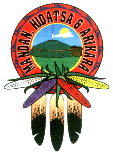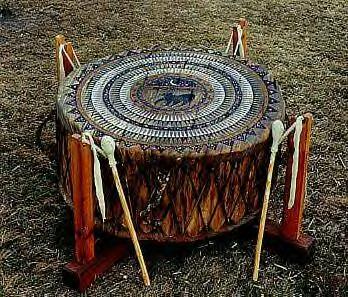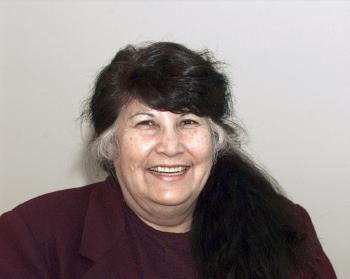|
 Just as I crossed Devils Lake on my way to visit a relative on the Spirit Lake reservation, I couldn't
miss a large bald eagle sitting on a dead limb at the edge of the lake. Its feathers were still fluffed as it settled
down to watch the morning traffic of fishermen, gamblers and the locals. Just as I crossed Devils Lake on my way to visit a relative on the Spirit Lake reservation, I couldn't
miss a large bald eagle sitting on a dead limb at the edge of the lake. Its feathers were still fluffed as it settled
down to watch the morning traffic of fishermen, gamblers and the locals.
Some say it is good
luck to see an eagle. I hoped that was true because my purpose at Spirit Lake was to help preserve some of the
old Sahnish (Arikara) songs.
My relative, who
lived on the Spirit Lake Reservation and away from the White Shield area for many years, knows the old Arikara
songs. We brought two singing experts from White Shield to sing those songs, too, and my relative's two sons helped.
The reason for recording
these old songs for the Sahnish is that some of the pieces (some of which are part of the ceremonies) have been
lost because they are no longer used and weren't passed on to younger singers. All of the songs that were sung
in those days were from memory -- the singers were the song books. When a singer died, the songs died with them,
if those songs hadn't been picked up by another singer.
The recordings we
made will be used as part of a project to preserve the culture for the young people. One day, they will want to
reach back to those times for strength and with the use of today's technology, they will be able to.
The Native music
today is somewhat different because many of the songs performed at powwows have more rhythm than words, one of
the singers told me. Part of the reason is that some of the younger singers did not understand the language. After
each of the songs were sung, one of the singers would explain the purpose of the song and sometimes translate the
English into Sahnish.
 That morning, the new drum made by my relative was set
up in the living room. As the men started drumming, I was mesmerized as I watched the five sticks hit the hide
-- they were like one -- with an occasional drummer breaking away to emphasize the sound. That morning, the new drum made by my relative was set
up in the living room. As the men started drumming, I was mesmerized as I watched the five sticks hit the hide
-- they were like one -- with an occasional drummer breaking away to emphasize the sound.
In between songs,
two of the elder singers laughed and teased each other with stories about their younger days. Some of those stories
were of the days when they sat at the knee of their father or grandfather and learned the songs in a medicine lodge
-- the "round house" in Nishu, the Sahnish community at Ft. Berthold.
Sometimes, in the
middle of one of their teasing stories about each other, one of the singers would start to softly drum. With the
rhythm established, he would began to sing the song softly, looking at the other two singers who would begin to
follow until they all remembered the song. When they all knew the song, they'd hit the hide and began to sing.
They sang military
songs -- these were all honor songs. Then they recalled the honor songs of many people who are now gone. My uncle,
my father and cousin's songs were the ones I remembered. Many tribes, but particularly the tribes from North Dakota,
have their own songs and many have two names -- one that is used for the white man's world and the other, a Native
name.
 Even those who were sitting in the dining room listening
knew from the sounds that the song was a prayer or a farewell song. Those honor songs about individuals or men
in the military were proud and full of hard sounds, and were distinctive also. Even those who were sitting in the dining room listening
knew from the sounds that the song was a prayer or a farewell song. Those honor songs about individuals or men
in the military were proud and full of hard sounds, and were distinctive also.
It was a good day.
I learned, I remembered from the stories and I felt good that someday, the grandchildren and their grandchildren
after that could hear these old songs.
I am Dorreen Yellow
Bird, Sahnish (Arikara) from the Three Affiliated Tribes at New Town, North Dakota. I am a journalist for the Grand
Forks Herald, Grand Forks, North Dakota. I write two columns per week, do the book page and reviews, a section
called Prairie Voices and stories as assigned by my editor. I also do some freelance writing for other magazines
and newspapers that are not mainstream, unlike the Grand Forks Herald, a Knight-Ridder newspaper. I am a member
of the Native American Journalist Association (NAJA).. E-mail Dorreen at dyellowbird@gfherald.com or she can be
reached at (701) 780-1228.
Mandan, Hidatsa and Arikara Homepage
http://web.ndak.net/~tatlegal/
North Dakota Native Americans
http://www.500nations.com/nd/index.html
|


